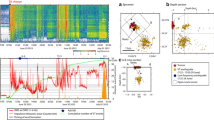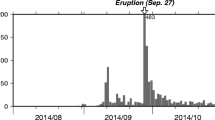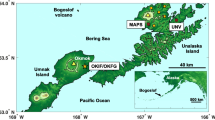Abstract
Isolated-type tremors having two events with different dominant frequencies are characteristic seismological phenomena observed during the fumarolic activity stage at Aso Volcano. These isolated tremors are called hybrid tremors (HBT) and comprise two parts: an initial part named the “HF-part” with a dominant frequency in the high-frequency region (approximately 10 Hz) and the following part named the “LF-part” with a dominant frequency in the low-frequency region (approximately 2 Hz). The LF-part is observed after the HF-part, and the HBT is accompanied by a long-period tremor (LPT). Hypocenters and source parameters are estimated using seismograms recorded at 64 stations around Nakadake crater. The amplitude distributions of all HF-parts have almost similar trends. Similarly, the amplitude distributions of all LF-parts have almost similar trends. However, the amplitude distributions of HF- and LF-parts are not similar. From these results, we proposed that the hypocenters and source parameters of HF- and LF-parts are not common, but each of them have common hypocenters and source parameters. The hypocenter region of HF-parts was estimated to be just beneath the fumarole region south of the 1st crater: the volume fluctuation is the major source factor. The hypocenter region of LF-parts is estimated to be at a depth of approximately 300 m beneath the first crater: the strike–slip component is the major source parameter. The hypocentral depth of LF-parts is located at the upper end of the crack estimated to be the source of the LPTs. The LPTs and HBTs are observed almost simultaneously. We consider that volcanic fluid is involved in the source mechanisms of both HBT and LPT.















Similar content being viewed by others
References
Brace WF, Paulding BW, Scholz C (1966) Dilatancy in the fracture of crystalline rocks. J Geophys Res 71:3939–3953
Chouet B, Saccorotti G, Dawson P, Martini M, Scarpa R, DeLuca G, Milana G, Cattaneo M (1999) Broadband measurements of the sources of explosions at Stromboli Volcano, Italy. J Geophys Res 102:15129–15150
Fujita E, Ida Y, Oikawa J (1995) Eigen oscillation of a fluid sphere and source mechanism of harmonic volcanic tremor. J Volcanol Geotherm Res 69:365–378
Hase H, Hashimoto T, Sakanaka S, Kanda W, Tanaka Y (2005) Hydrothermal system beneath Aso volcano as inferred from self-potential mapping and resistivity structure. J Volcanol Geotherm Res 143:259–277
Hurst AW (1992) Stochastic simulation of volcanic tremor from Ruapehu. J Volcanol Geotherm Res 51:185–198
Japan Meteorological Agency (2005) National catalogue of the active volcanoes in Japan (Third edition). Japan Meteorological Agency, pp 1–635, (in Japanese)
Kaneshima S, Kawakatsu H, Matsubayashi H, Sudo Y, Tsutsui T, Ohminato T, Ito H, Uhira K, Yamasato H, Oikawa J, Takeo M, Iidaka T (1996) Mechanism of phreatic eruptions at Aso volcano inferred from near-field broadband seismic observations. Science 273:642–645
Kawakatsu H, Ohminato T, Ito H, Kuwahara Y (1992) Broadband seismic observation at Sakurajima Volcano, Japan. Geophys Res Lett 19:1959–1962
Kawakatsu H, Ohminato T, Ito H (1994) 10s period volcanic tremors observed over a wide area in southwestern Japan. Geophys Res Lett 21:1963–1966
Kawakatsu H, Kaneshima S, Matsubayashi H, Ohminato T, Sudo Y, Tsutsui T, Uhira K, Yamasato H, Ito H, Legrand D (2000) Aso94: Aso seismic observation with broadband instruments. J Volcanol Geotherm Res 101:129–154
Kikuchi S (1962) On the short period volcanic micro-tremors at Mt. Aso. Bull Volcanol Soc Jpn 7:1–16, (in Japanese)
Kubotera A (1974) In: Civetta L, Gasparini P, Luongo G, Rapolla A (eds) Volcanic tremors at Aso volcano. Physical Volcanology, Elsevier, pp 29–47
Kuwahara Y, Itoh H, Kawakatsu H, Ohminato T, Kiguchi T (1997) Crustal heterogeneity as inferred from seismic coda wave decomposition by small-aperture array observation. Phys Earth Planet Inter 104:247–256
Legrand D, Kaneshima S, Kawakatsu H (2000) Moment tensor analysis of near-field broadband waveforms observed at Aso Volcano, Japan. J Volcanol Geotherm Res 101:155–169
Miller AD, Stewart RC, White RA, Luckett R, Baptie BJ, Aspinall WP, Latchman JL, Lynch LL, Voight B (1998) Seismicity associated with dome growth and collapse at the Soufriere Hills Volcano, Montserrat. Geophys Res Lett 25:3401–3404
Mori T, Notsu K (1997) Remote CO, COS, CO2, SO2, HCl detection and temperature estimation of volcanic gas. Geophys Res Lett 24:2047–2050
Mori T, Mori T, Kazahaya K, Ohwada M, Hirabayashi J, Yoshikawa S (2006) Effect of UV scattering on SO2 emission rate measurements. Geophys Res Lett 33:L17315
Neidel N, Tarner MT (1971) Semblance and other coherency measures for multichannel data. Geophysics 36:483–497
Ono H, Hoka T (1984) Seismic activity near the Nakadake, Volcano Aso in 1981. Joint Geophysical and Geochemical Observations of Aso Volcano: 7–16, (in Japanese)
Ono K, Watanabe K (1985) Geological map of Volcanoes 4; Geological map of Aso Volcano 1: 50000. Geological survey of Japan, Tsukuba, (in Japanese)
Sassa K (1935) Volcanic micro-tremors and eruption-earthquakes (part 1 of the geophysical studies on the Volcano Aso). Mem Coll Sci Kyoto Univ 18:255–293
Seidl D, Kirbani SB, Brüstle W (1990) Maximum entropy spectral analysis of volcanic tremor using data from Etna (Sicily) and Merapi (central Java). Bull Volcanol 52:460–474
Shima M (1958) On the second volcanic micro-tremor at the Volcano Aso. Disaster Prevent Res Inst Kyoto Univ Bull 22:1–6
Shimizu H, Ueki S, Koyama J, Takagi A (1984) Mechanisms of volcanic earthquakes following the 1983 eruption of Miyakejima. Bull Volcanol Soc Jpn 29:S81–S100, (in Japanese)
Sudo Y, 89 persons (2002) 1998 seismic exploration, Aso98, in Aso Volcano. Bull Earthq Res Inst 77:303–336
Takagi N, Kaneshima S, Kawakatsu H, Yamamoto M, Sudo Y, Ohkura T, Yoshikawa S, Mori T (2006) Apparent migration of tremor source synchronized with the change in the tremor amplitude observed at Aso volcano, Japan. J Volcanol Geotherm Res 154:181–200
Tanaka Y (1994) Eruption mechanism as inferred from geomagnetic changes with special attention to the 1989–1990 activity of Aso Volcano. J Volcanol Geotherm Res 56:319–338
Tsutsui T, Sudo Y (2004) Seismic reflectors beneath the central cones of Aso Volcano, Kyushu, Japan. J Volcanol Geotherm Res 131:33–58
Yamamoto M, Kawakatsu H, Kaneshima S, Mori T, Tsutsui T, Sudo Y, Morita Y (1999a) Detection of a crack-like conduit beneath the active crater at Aso Volcano, Japan. Geophys Res Lett 26:3677–3680
Yamamoto M, Kawakatsu H, Kaneshima S, Iidaka T, Oikawa J, Watada S, Morita Y, Mori T, Tsutsui T, Sudo Y, Yoshikawa S, Hashimoto T, Nakaboh M (1999b) ASOBOI97: Aso Seismic Observation with Broadband Instruments in 1997. Bulletin of the Earthquake Research Institute 74:267–285
Yoshikawa S, Kitsunezaki C (1959) On the short period volcanic micro-tremors at volcano Aso. Bull Volcanol Soc Jpn 3:147–153, (in Japanese)
Yoshikawa S, Sudo Y (2004) Volcanic activity and surface temperature variation of crater lake in Naka-dake crater at Aso volcano. Annuals of Disas Prev Res Inst Kyoto Univ 47:803–807, (in Japanese)
Acknowledgements
We are grateful to the staff members of the Aso Volcanological Laboratory, Kyoto University. We also thank Drs. J. Hirabayashi and K. Nogami of the Volcanic Fluid Research Center, Tokyo Institute of Technology, for their support. The authors are indebted to the thoughtful and helpful comments from Dr. A. W. Hurst of GNS, New Zealand; Drs. K. Ishihara and M. Iguchi, Sakurajima Volcano Research Center, Kyoto University; and Dr. H. Shinohara, Geological Survey of Japan, AIST. We would like to thank Dr. E. Marchetti, Dr. M. Ripepe, and two anonymous reviewers for their constructive comments. The data used in this study were obtained from the National Project for Prediction of Volcanic Eruptions (Project ASO98). We also thank all the members of Project ASO98.
Author information
Authors and Affiliations
Corresponding author
Additional information
Editorial responsibility: M Ripepe
Rights and permissions
About this article
Cite this article
Mori, T., Sudo, Y., Tsutsui, T. et al. Characteristics of isolated hybrid tremor (HBT) during a calm activity period at Aso Volcano. Bull Volcanol 70, 1031–1042 (2008). https://doi.org/10.1007/s00445-007-0185-7
Received:
Accepted:
Published:
Issue Date:
DOI: https://doi.org/10.1007/s00445-007-0185-7




